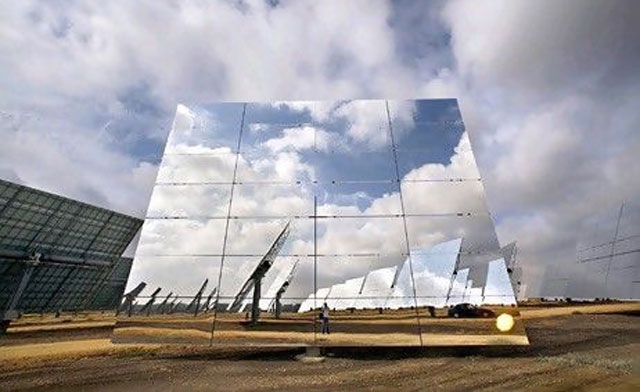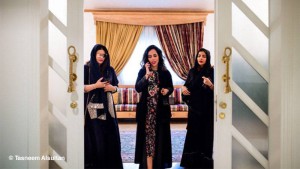Thin film modules are increasingly finding their way into Middle East installations, with Saudi Aramco and Dubai Electricity and Water Authority (DEWA) both opting for thin film in their latest renewable energy projects.
Perfectly positioned around the Sun Belt, the Middle East and North Africa (MENA) region, where outdoor installations dominate, can largely benefit from thin film solar cells over crystalline silicon. Not only can thin film panels perform much better at high temperatures and in outdoor applications, but the region’s abundant solar resources can shorten the energy payback time.
Utility choice
The fact that DEWA selected thin film PV manufacturer First Solar for the construction of the first phase of the $3.3bn Mohammad Bin Rashid Al Maktoum Solar Park proves the utility’s confidence in thin film technology as a viable option for Dubai. “There is a tremendous amount of potential for thin film in the region. We believe that our advanced thin film modules are well-suited to the Middle East and North Africa’s very specific needs,” says Christopher Burghardt, vice president of business development at First Solar, Europe Middle East and Africa. Certified for their hot weather performance, First Solar modules produce more energy at temperatures above 25°C than traditional crystalline silicon solar modules for the same nameplate watts. “The performance of our Series 3 Black modules in a wide range of operating environments was validated by the IEC 60068-2-68 “sand and dust test” certification, which measures durability in harsh desert environments characterized by blowing abrasive sand,” Burghardt tells PV Insider. The certification complements First Solar’s existing IEC salt mist and ammonia certifications, providing a range of independent testing that reflects world-class durability and performance in the harshest operating conditions. Armed with these certifications and an impressive track record in engineering procurement, construction (EPC), as well as module supply, the American company landed the EPC contact for its first installation in the MENA region. The 13 MW PV plant in Dubai, now 70% complete, is on schedule for commissioning in October and is expected to produce power at a cost of 10 to 14 cents per kilowatt-hour. In addition, First Solar is supplying Masdar with half of the 10 MW solar panels for Masdar City in Abu Dhabi. With two projects in the UAE, First Solar recently opened offices in Dubai’s ENPARK. And in Saudi Arabia, where 16 GW of PV generation will be added over the next two decades, First Solar is in the process of establishing a second operational centre. To further strengthen its portfolio, the company recently acquired GE’s cadmium telluride (CdTe) intellectual thin film PV property, which holds the world-record for CdTe thin film cell efficiency at 19.6%. According to First Solar, GE’s technology is compatible with its manufacturing platform, and will be eventually integrated.
Exceeding output
Meanwhile, Tokyo-based CIS thin film manufacturer Solar Frontier is also expanding into the MENA region. “We have opened an office in Al Khobar, which will play a key role in expanding Solar Frontier’s overall presence in Middle Eastern growth markets, while building on our long-term relationship with Saudi Electricity Company and Saudi Aramco,” Wolfgang Lange, General Manager of Solar Frontier Europe, told PV Insider. Solar Frontier’s 10.5 MW solar park installation at Saudi Aramco’s Al-Midra Tower facility in Dharhan marked six months of operations last July, producing a higher-than-expected output of 8,498 MWh since completion. The Japanese firm attributed the strong output to the superior temperature coefficient of its CIS modules, which have the additional benefit of being free of cadmium and lead. “CIS modules have a lower temperature coefficient than standard crystalline technologies; as a result, they are more resistant to heat degradation and deliver up to 5% more power than standard crystalline modules at 75C° (167F°) module temperatures”, the company said in a statement. According to Solar Frontier, Al Midra installation is the largest of its kind in the region, with modules covering 4,450 car parking spaces over an area of 16-18 hectares, producing all of the building’s daytime power needs.
Managing desert operation
Because of the harsh desert conditions of Saudi Arabia’s Eastern Province – where the solar park is located – the installation must be periodically cleaned to combat the negative impact of sandy winds and constant dust. What really makes the difference, however, is that Solar Frontier’s support structure has been designed with these environmental effects in mind. The advantages of Solar Frontier’s proprietary CIS technology in desert climates, according to Lange, include “a lower temperature coefficient compared to crystalline silicon – meaning a smaller loss in conversion efficiency as temperatures increase, a strong frame reinforcement that is tapered to resist sand and dust accumulation, and durable construction assured by high quality Japanese manufacturing”. Solar Frontier is 100 per cent owned by Showa Shell, a subsidiary of Royal Dutch Shell, which made a $1bn investment in Solar Frontier’s factory. The company now operates from its headquarters in Japan, as well as Germany, USA, and Saudi Arabia, and is looking to strengthen its position as an Independent Power producer, with several such projects already in the pipeline. “The Middle East is one of our priority markets and a market with huge growth potential in the PV sector. Saudi Arabia, for example, receives significantly more energy per square meter than a “sunny” country like Spain. The countries of Africa’s sun belt are especially interesting to us as well,” notes Lange. Thin film production is currently dominated by Solar Frontier and First Solar, which together will account for almost 75% of thin film production in 2014, according to NBD SolarBuzz. Both companies are focused on downstream projects as a means of driving internal production, and are expected to add new thin film manufacturing capacity between 2014 and 2017. The added capacity will come just in time for Saudi Arabia’s introductory renewable energy bidding round; expected to take place in 2014. In Dubai, a 100 MW facility using PV technology will also be put out to tender soon, as revealed by Saeed Al Tayer, vice chairman of the Supreme Council of Energy, although the schedule has not been announced yet. While the focus for new thin film capacity in the past was in Europe and the United States, emerging markets across the MENA region as well as Latin America and South Africa are likely provide the funding and resources for the next investment cycle.
Source: PV Insider






Aún no hay comentarios, ¡añada su voz abajo!